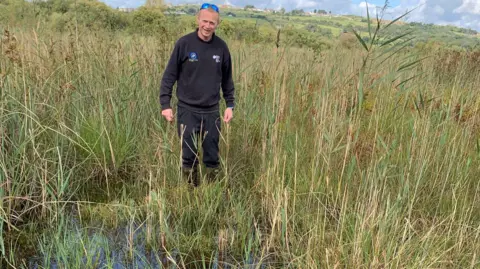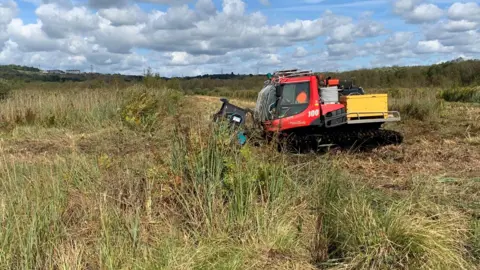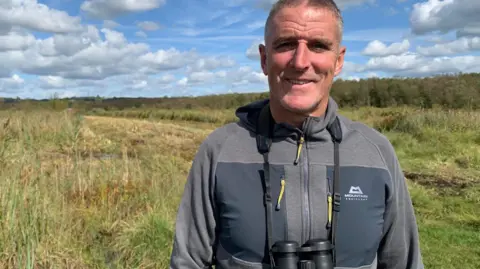Preserving a wobbly bog dotted with WW2 bombs
 BBC
BBCPreserving a wobbly bog, described as "a real gem in Wales' natural crown" is being made slightly more tricky by the presence of unexploded World War Two bombs.
Crymlyn bog on the outskirts of Swansea is the largest of Wales' last remaining quaking bogs - earning its name as the peatland habitat literally shakes under your feet.
But these bogs are under threat due to damage caused by drainage, pollution and neglect and are part of a £5m restoration project.
LIFEquake senior project officer Gareth Thomas said unexploded Luftwaffe bombs meant "we can't break ground on the site" without carrying out specialist tests.
Llandarcy Oil Refinery, which opened next to the bog in 1922, became a major target for the German military during World War Two and was attacked in a series of air raids.
Mr Thomas said the Luftwaffe "hit the hillside opposite us which has resulted in leaking hydrocarbons into the bog that currently locked away in the peat".
He added: "We can't break ground on the site without carrying out magnetometers surveys."
The potential for finding unexploded bombs is high - during that period of the war, the failure rate was about 40%, meaning there could easily be intact explosives there.
Mr Thomas said, when digging wells across the site last year, they had to use magnetometers "to make sure we weren't going to inadvertently poke a bomb".

LIFEquake is now entering what is being described as a "crucial phase" with clearance and restoration work.
It is mainly focusing in Crymlyn, which is within a stone's throw of Swansea city centre and dates back 7,000 years.
Over the years its neighbours have included an oil refinery, power station, rubbish tip and numerous coal mines and yet the bog has remained largely intact.
"Crymlyn's a really unusual peatland site," said Mr Thomas.
"It has been important to the development of Swansea for the last 250-plus years, with links with the coal, copper and oil industries."

Peatland covers 4% of Wales yet holds 30% of its land-based carbon, but 90% of it is in an unfavourable condition and emits greenhouse gases.
To tackle this, the Welsh government set a target in 2020 to restore 3,000 hectares of peatland, which ministers said had now been completed a year ahead of schedule.
Deputy First Minister Huw Irranca Davies said: "Wales is facing a climate and nature emergency and this work goes a long way to ensure these precious habitats can survive and adapt in a changing climate."
Mr Thomas said the quaking bog was partly caused as "vegetation has grown together across the surface of a water body, so beneath it is still very, very saturated and the peat is growing downwards at a rate of a millimetre per year".

Conservationist and TV presenter Iolo Williams has described the bog as "unique" with "a wealth of amazing wildlife".
Birds are also a feature of the site - reed warblers and sedge warblers breed here, along with Cetti's warbler, grasshopper warbler, reed bunting and water rail.
But perhaps its rarest visitor is Britain's largest spider, the fen raft spider, though it is very difficult to see it as it is confined to open water areas.
"It's one of the only place in Wales you can find it," said Nick Thomas, strategic project manager for Natural Resources Wales.
The main problem with many peatlands across the UK is that they are drying out.
But in Swansea, it is a different story - there is too much water on the site and the restoration team is trying to drain some of that.
This involves reopening the Glanywern canal, built in 1790, which runs through the middle of the bog and was used to carry coal to the city for copper smelting.
The water is slightly polluted because of old coal mines and landfill sites that used to surround the edge and the water has to be filtered so no pollutants escape.
Crymlyn's quaking bog is a National Nature Reserve and Special Area of Conservation and is home to a treasure trove of vegetation and wildlife.
The site has a long history, but the aim now is to restore the wetland to ensure it has a healthy and thriving future.
